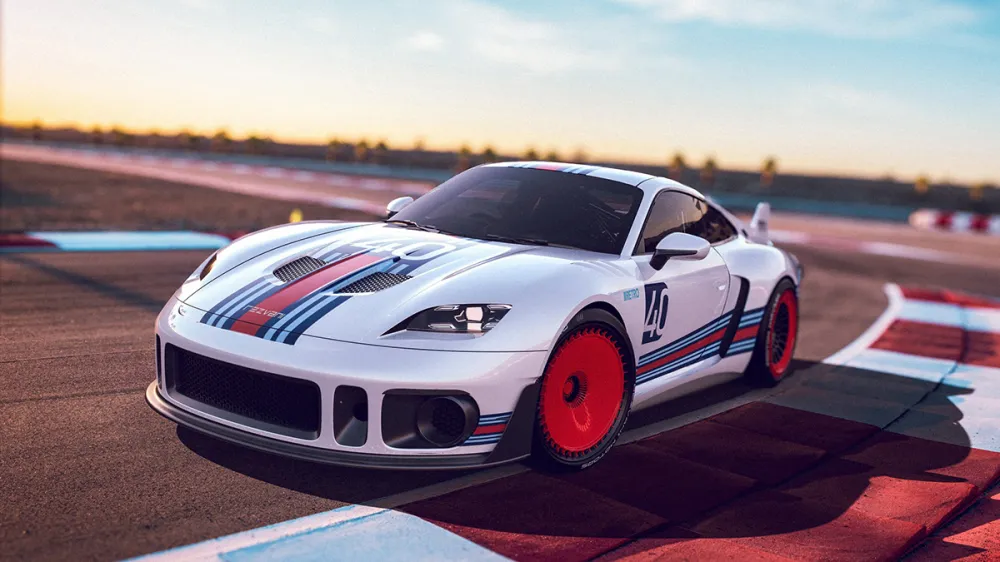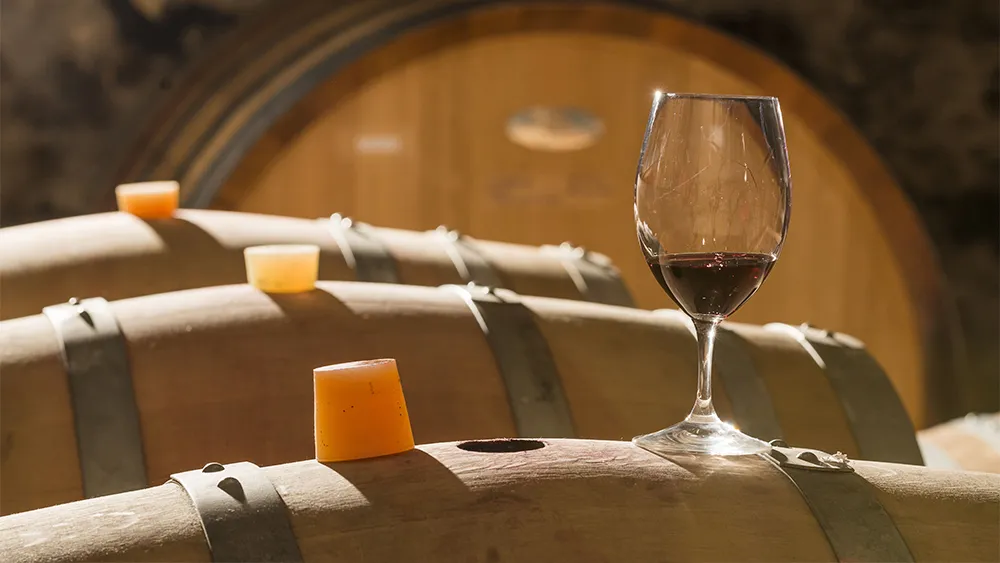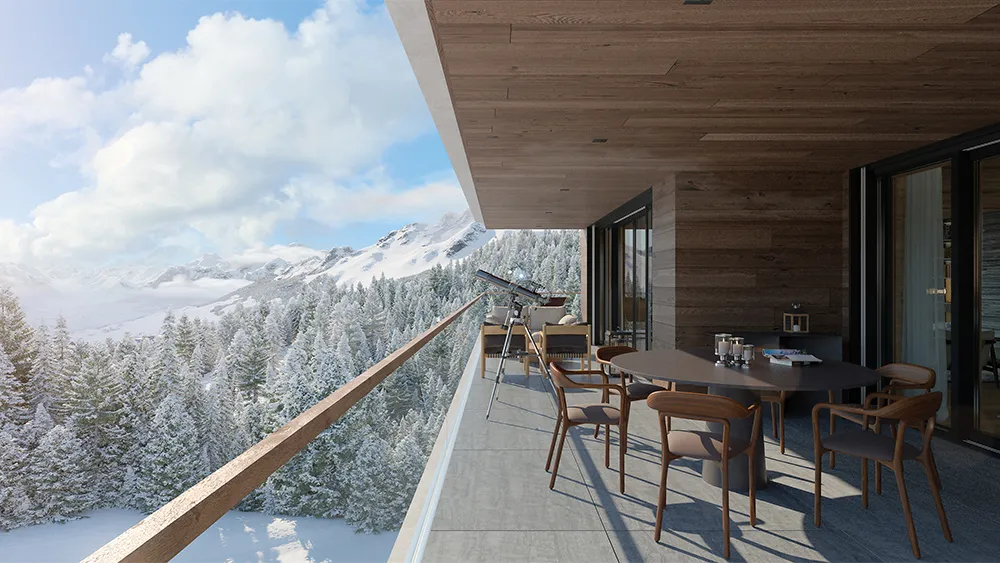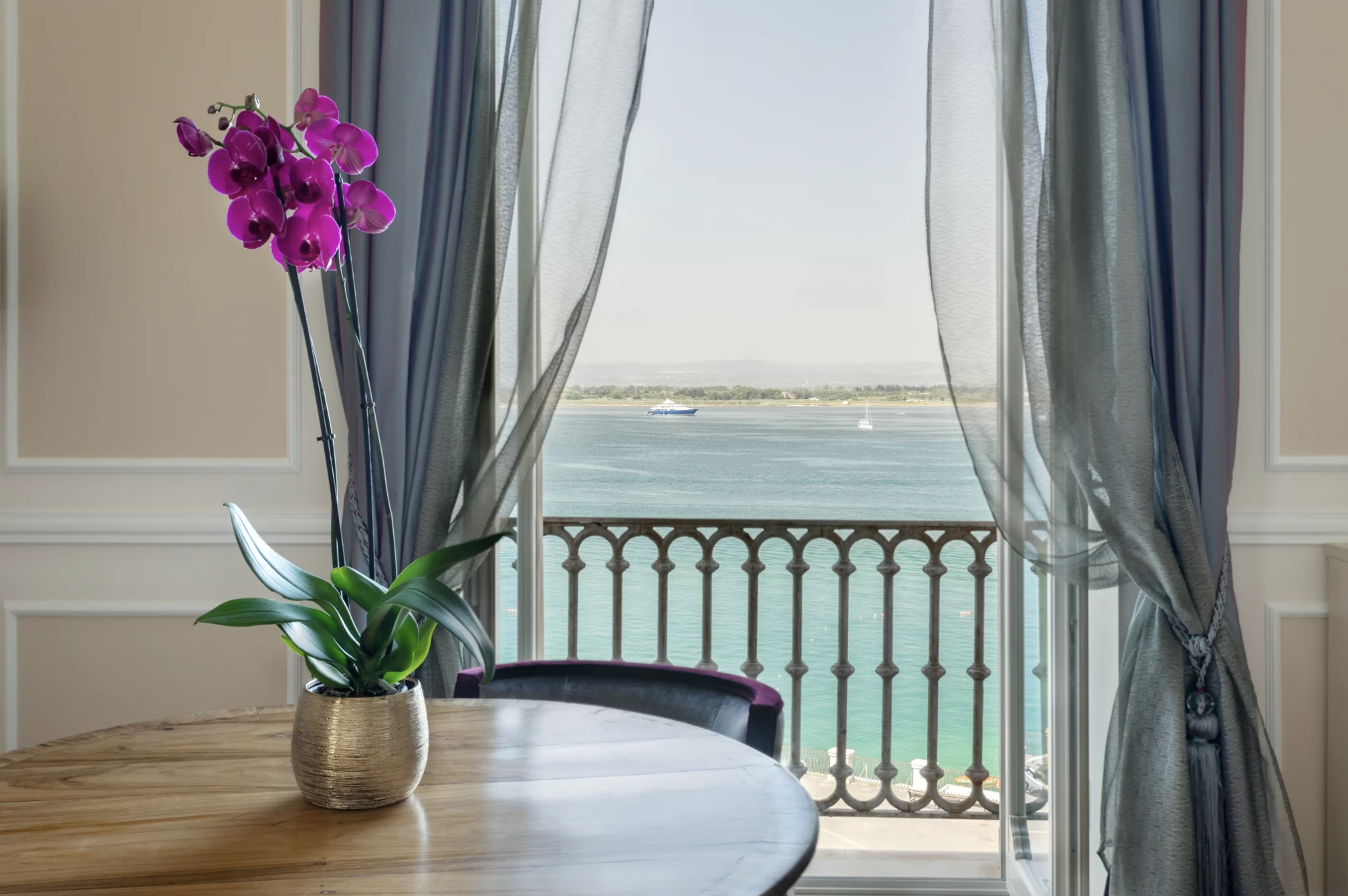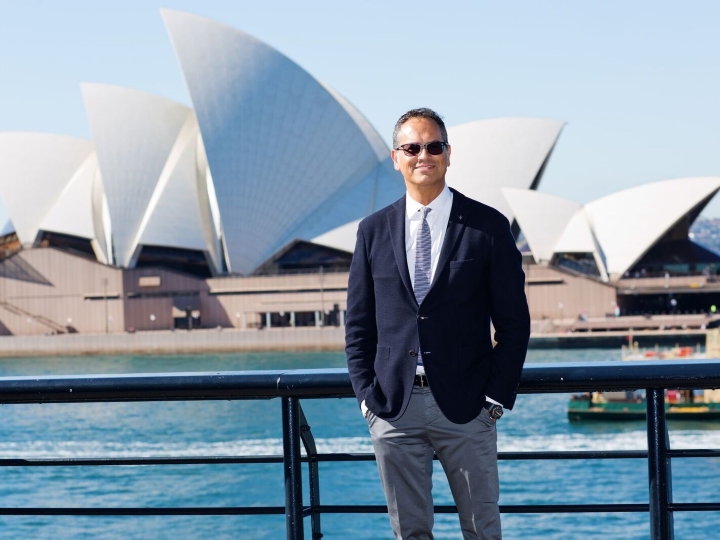
The supercar sculptor
Sardinian-born Flavio Manzoni spent his childhood wishing he’d designed the Sydney Opera House. Today, his creations house an even more stirring musical performance.
Related articles
How is one supposed to carry the weight of one of the world’s most powerful brands, the responsibility for a technological leader and a national institution? If you’re Flavio Manzoni, senior vice-president of design at Ferrari, you carry it on slender shoulders, with graciousness and an engaging, boyish enthusiasm.
On this particular day, Manzoni’s wide-eyed wonderment had a lot to do with his being in Australia for the first time. He visited in late May as a special guest speaker for Sydney’s Vivid festival. He also presented his latest creation, the four-seat, four-wheel-drive GTC4Lusso V12, and sat down for a one-on-one interview with Robb Report Australia.
He modestly deflects credit for the Lusso’s design – and that of every current Ferrari model, including the stratospheric LaFerrari supercar – onto his 75-strong team at the Ferrari Centro Stile. And Manzoni cites that very team as his proudest creation: prior to his arrival in January 2010, Ferrari was the only major automotive brand still lacking in-house design.
Manzoni is slim, bespectacled, stylish in a slightly nerdy way. He keeps fit by cycling, is an avid and accomplished pianist and is encyclopaedic in his knowledge of classical music. With an embarrassed laugh, he refers to the 708kW, 350km/h-plus LaFerrari supercar as a “beast”; the 574kW, 340km/h F12 Tour de France as a “monster”.

Manzoni was born in 1965 in Sardinia – the island’s culture, he says, is in his soul – as the son of an architect. Cars weren’t a particular focus, but capturing thoughts and images came naturally. “When I was a child, it was normal for me to visualise an object and the morning after, sketch it, just to freeze it, materialise it,” he says.
He says he dreamed of Australia even then. More specifically, of the Sydney Opera House. “When I was a child and I was dreaming to become an architect, this was among the five best [buildings] that I really loved,” he sighs. “I was very impressed that in 1957 a very young architect, Jørn Utzon, was imagining the future like this. If you look at [the Opera House] now, you think this has been designed now, thinking towards the future. And however many years later, this is really impressive.
“It makes us think how we are forgetting this approach. It is absolutely important to think in a very audacious way, let’s say a bold way, symbolic way. There is everything on this building; it is a masterpiece of symbolism. And I noticed yesterday, visiting the building, there are four dimensions – there is time as well.”
At 18, Manzoni left Sardinia to study architecture and industrial design at the University of Florence. On graduating, he decided to pursue a career in automotive design. He joined Fiat in 1993, spending six years in the design centre with the upscale Lancia brand, half that time as senior interior designer, before detouring to the Volkswagen-owned SEAT where he again specialised in interior design. He returned to Lancia in 2001 as overall Director of Design for the ailing brand.
Moving to parent Fiat in 2004, Manzoni oversaw the design of mainstream models like the retro-themed 500. A move to Volkswagen in 2006, where he was soon heading the group’s creative design, involved him in everything from the space-maximising Up! series of concepts, to the mainstream Golf VI, to designing the identities for Bentley and Bugatti.

Then, in 2009, Maranello came a-calling. Manzoni’s appointment was confirmed in January 2010. Ferrari had never fully taken the plunge before. As Manzoni sits down with Robb Report Australia in Sydney, he explains it had been that way from the beginning, when founder Enzo Ferrari agreed (with supposed reluctance) to produce and sell gran turismo road models in order to fund his racing scuderia.
“Enzo Ferrari used outside coachbuilders,” Manzoni says. “He didn’t care about production. He had to sell the cars to sustain the racers. There was a famous encounter between him and Pininfarina, and he committed to create the GT cars.”
From 1947 to 2010, all but a handful of Ferrari’s most iconic models were clothed by the independent Turin design house of Pininfarina.
Ferrari had put a toe in the water in late 2002 when, with fellow Modenese marque Maserati then in its stable, it appointed former BMW and MINI (now McLaren) designer Frank Stephenson as Director of Concept Design and Development.
Stephenson’s role was not to actually design cars, but to assist independent designers (like Pininfarina luminary Lorenzo Ramaciotti) in maintaining each brand’s identity. He was replaced in 2005 by Donato Coco, under whose watch were developed the Ferrari F430, California and the gorgeous 458 Italia. Coco moved on to British marque Lotus, as Ferrari successfully wooed Manzoni.
“I started in 2010 with the commitment of starting from scratch an entire studio,” Manzoni says. “We were four [people] at the beginning, now we are more than 75 …”
After completing revisions to the Pininfarina-penned FF – the “shooting brake” profile, re-employed in the GTC4Lusso – Manzoni and his young team had the ultimate challenge of Ferrari’s next supercar flagship, the LaFerrari. Acceptance of their efforts wasn’t a given. At the end of 2010, his small in-house team anxiously presented six full-scale clay models to Ferrari management … who gave the nod to move forward with two of them.

“It was the first big success for us – a demonstration that a talented team, working in-house, can produce a very high result,” Manzoni reflects. “The final part of the job was a very long process of optimisation. We remodelled, we redesigned every millimetre of this shape in order to reach the best compromise in terms of performance and beauty.”
Manzoni’s presentation at Vivid Sydney kept an audience of 200 enthralled in the Museum of Contemporary Art, recounting the design process of the LaFerrari. A very early step, he explained, was to take the naked carbon-fibre chassis as presented by the engineers and visualise (via 3D-modelling) the flow of air over it to create a “ghost body”.
“This car is made from carbon fibre and air,” Manzoni told the audience. “There are two forces which condition the configuration of a car like this. One is the air, and that tends to excavate the body. The other one is the amount of components that you have to put inside. Two opposite forces.”
Another force, strong in Manzoni, is authenticity. Fake grilles and wings, he says, aren’t design; merely styling. “Ferrari, we never make something only because we like it. It is not possible. There is always a rational process of selection that is based on also a rational criteria. If you have a beautiful idea but it doesn’t fit the purpose or the content of the product, it stops.”
Ferrari, though, has probably a richer seam of emotive visual cues than any other automotive brand. A tail-lamp shape, a ducktail spoiler, a pair of outlets angled just-so, that instantly denote the prancing horse. But Manzoni feels that regurgitating the past is cowardly, unless it’s done in an authentically innovative way.
“How can we combine a visionary approach with the respect for the tradition?” Manzoni rhetorically asked the Vivid audience. “There is a relationship between man and machine … It refers to symbols that have a strong impact on our imagination. The look of the object is very often provocative, there is a seductive encounter with the user, which is strongly emotional.”
At the nose of the LaFerrari, the front splitter appears to be suspended from a central, vertical element. It’s a fitting, functional solution – which happened to subtly recall the 1961 Ferrari 156 “shark-nose” Formula 1 car.
Similarly, the need to relieve pressure from the rear wheel-arches of the latest F12 Tour de France GT car found a neat solution in three, slanted air outlets. While in complete functional and aesthetic harmony with the F12’s innovative, excavated channels, they’re suggestive of the 1962 250 GTO.“It is a kind of conceptual approach that connects our products to the past, but not in a nostalgic way – in a very futuristic way,” explains Manzoni. “And if you look back, there are so many Ferraris that are so different from their predecessors. This means that the designers at the time were not so much influenced by the history. They just wanted to reinvent the future of Ferrari.”
More than he is proud of any of his designs, Manzoni says he is proud of a team that works “so fast – like in Formula 1”. The design time for a new Ferrari model, he says, is a staggering 14 months from first sketch to design freeze, after which it is handed over for the rather longer process of production engineering.
That design timeframe includes modelling in clay, which Manzoni insists is essential. “The modellers – who are real artists, sculptors – work on the right tension and the sexy effect of the surfaces that sometimes doesn’t come with virtual modelling. The human touch is very important to give a certain sensitivity, sensibility to the form.”
Fourteen months? Manzoni breaks into a smile. “LaFerrari took a longer time. But fortunately we are Italian, so we know very well the art of improvisation! We plan for 14 months, but sometimes that is not sufficient if you want to achieve the result of excellence.”
All of which largely explains the need for the Ferrari Centro Stile itself. “Nowadays the Ferraris are so complex, it’s not possible any more to find the technical configuration and then give it to somebody else to make a suit on top,” Manzoni says. “It’s an integrated design. We still cooperate with Pininfarina, especially for the one-off projects. It means they make their interpretation based on a production car. Historically, this is the tradition of a coachbuilder.”
Car designers are unfailingly among the most fascinating people one meets. Automotive design embodies almost every kind of design – architectural, furnishing, appliances, electronics – and does so within an endlessly demanding framework of vibration, heat, exposure to the environment and differing legislative requirements. Added to that is the range of cultural tastes to be satisfied by a product that will appear, at best, two years after the design has been signed off. Automotive designers never cease observing and absorbing cultures, colours, contours, textures, even sounds. Manzoni often mentions the “short-circuits” that occur between often unrelated fields like architecture, art, music – from which something new can be invented. How was Australia seeping into Manzoni’s consciousness?
“I can speak only about what I’ve seen so far,” he smiles. “Sometimes I have the feeling of an American city, because of the very modern buildings. But there is a very special, local and authentic character of the environment. I love this combination of natural beauty of the land.”
He had toured Sydney’s eastern suburbs, loading his iPhone – a cracked and weather-beaten example – with images of clifftop houses and curious, wind and water-hewn sandstone formations.
“It’s unbelievable, the cliffs are fantastic, and the integration between architecture and nature. There is a kind of connection there. I saw many beautiful villas on the cliffs … This landscape looks like an oil painting. And this villa, designed with a circular front and windows looking north-east and south-east. I think they can see the curvature of the earth from this.”
He shows us a series of photographs of rocks in Sydney’s Parsley Bay. Sandstone, layered and sculpted by the wind, pockmarked with bubbles like an Aero chocolate. “This reminds me of Antelope Canyon in Utah, a canyon created by the wind. It is beautiful, incredible what nature can do. And here – a tree that was born in the stone …”
The sandstone formations might as easily have reminded him of Katsushika Hokusai’s famous woodblock The Great Wave off Kanagawa, a print of which is prominent in the Ferrari Centro Stile in Maranello.
How do these lumps of rock help inspire the design of some of the world’s most advanced supercars? “I don’t know,” Manzoni shrugs. “I think I’m a very curious person, so I think it’s very important to nourish your creativity, your soul with different experiences. I’m sure they will naturally work in the background, influencing your choices, your ideas, your vision. This is a creation of nature, but it is like a sculpture.”
Creation, as he explains, doesn’t always happen when one is creating. “Normally, when I have to solve a problem, we sit in front of the model or we sit around the table, we make brainstormings with the team. But so many times, it happens in the moment where you have a pause. Spontaneously there is a kind of illumination – some intuition, some idea that comes naturally.”
He agrees that this intuition comes more naturally to Italians. “Italian design is better!” he laughs. “I think there is a higher emotional value that comes from the passion and enthusiasm that we have. I think we are naturally inclined to put a certain artistic quality on our best products. But not everything, uh? I have to be honest!”
Subscribe to the Newsletter
Recommended for you
8 Fascinating Facts You Didn’t Know About Aston Martin
The British sports car company is most famous as the vehicle of choice for James Bond, but Aston Martin has an interesting history beyond 007.
May 1, 2024
Rezvani Will Rebuild Your 911 to Go From Zero to 100 in Two Seconds
The shop will build a version of the RR1 based on the Carrera S, GT3, and Turbo S
By Bryan Hood
April 23, 2024
You may also like.
You may also like.
Minerality in Wine, Explained: How It Affects Taste, Aroma and Texture
And an exploration of the regions that produce great mineral-driven varietals.
If you have taken part in a wine tasting, read an article about wine, or even glanced at the back label of a bottle of wine, you have likely encountered the word minerality. But defining what that means exactly is where the problems can start—even wine experts disagree on what it is and how it expresses itself in the glass.
Minerality refers to a flavour profile and often a palpable sensation in the mouth. The flavours generally involve rocks or fossils, such as stone, river rock, flint, gravel, slate, asphalt and oyster shell. There is also a sense of salinity, often derived from volcanic soils, that is a component of mineral-driven wines. This is different from other earthy flavours such as forest floor or peat. When we host tastings, very few people will own up to having licked rocks as a child, but almost everyone has gotten a stray bit of oyster or clam shell in their mouth and can recall the taste and texture. Most of us can remember the scent of a chalkboard or pencil lead from our childhood, and even those who have never fired a gun are familiar with flint or gunpowder from firecrackers.
When minerality is discussed, it is often a quality ascribed to white wine such as Riesling, Assyrtiko, Sauvignon Blanc or Burgundian Chardonnay. We may not hear about minerality in red wine so much because the oak used for maturation may mask the flavours and aromas associated with minerality. However, two reds sometimes described as having mineral qualities are those from the volcanic soils of Mount Etna in Sicily and the shale and quartz vineyards of Priorat in Spain. A prime example of the mineral-driven style is Chablis in the northernmost reaches of Burgundy, whose wines are made with 100 percent Chardonnay. The wines have a distinctly different character than the oaky, buttery style prevalent in Napa Valley and further south in Burgundy.
Walking through the vineyards of Chablis you can see abundant fossilised oyster shells that date back 150 million years to the Upper Jurassic period, when this area was at the bottom of the sea. Dig a bit; you will find calcified ammonites and spiral-shaped cephalopods from the same era. While vineyard soil is a discussion for another day, the grey limestone here is called Kimmeridgian, named for the village of Kimmeridge in Dorset, England, where it was first identified. As Thierry Bellicaud, president of Domaine Laroche in Chablis told Robb Report, “The Kimmeridgian limestone soil, which is unique to this area, delivers all needed nutrients for the balance of the vines. The terroir nurtures the vines which then express its personality in the grapes.”
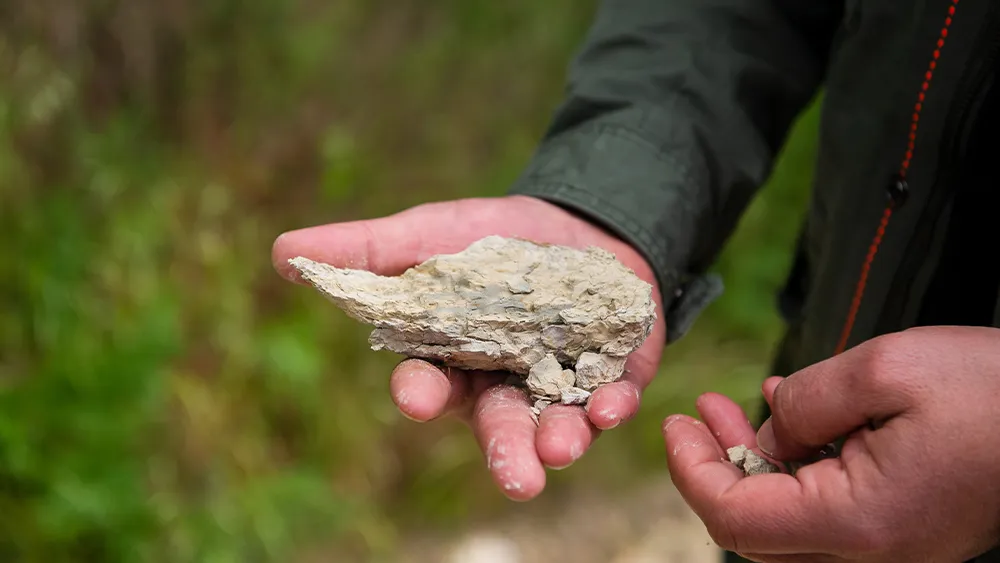
DOMAINE LAROCHE, CHABLIS, FRANCE
Asked how soil composition influences one of Domaine Laroche’s wines, Bellicaud referenced its Chablis Grand Cru Les Blanchots, “Les Blanchots is a unique terroir made of a layer of white clay on Kimmeridgian limestone with ammonites. This is the ideal combination to keep the right amount of water for the roots. The southeast exposure allows slow ripening and favours aroma development. It is one of the areas in the appellation where you can easily find oyster fossils (called Exogyra virgula). The Grand Cru Les Blanchots is delicate, refined and silky in texture.”
Assyrtiko from Santorini is almost always described as possessing a mineral quality as well as a touch of salinity, which can be attributed to the black volcanic soil in which it grows as well as to the Aegean Seaspray that wafts over the island’s vineyards. Mosel Valley Riesling’s leanness and flinty character come from the red and blue limestone in which it is cultivated.
Italy’s Soave region is also known for the minerality of its wine. Alessio Inama, third-generation family leader and director of sales, marketing and communication at Inama Azienda Agricola, told Robb Report, “Soave Classico is a volcanic region with soil made up of basaltic rocks, volcanic tuffs and ashes that date back 30 million years. The soils offer minerals in their natural form, which impact the composition of the plants themselves. In the case of grape vines, the soils have a major influence on the resulting flavours of the wines, which are mineral and floral.”
Known for their scrupulous mapping of micro-plots within their vineyards, the Inamas produce several different Soave wines made with the Garganega grape. Inama I Palchi Foscarino Grande Cuvée Soave DOC is crafted from the family’s best plots on Monte Foscarino. Inama explained, “The soil of Foscarino is a mix of pure magma, ashes and basaltic rocks that deteriorated over millions of years into a dark clay that is extremely rich in minerals. The grapes from those 40-year-old vines have strong personality, great intensity and texture, delivering a complex bouquet of white flowers, citrus notes and flinty sensations.”
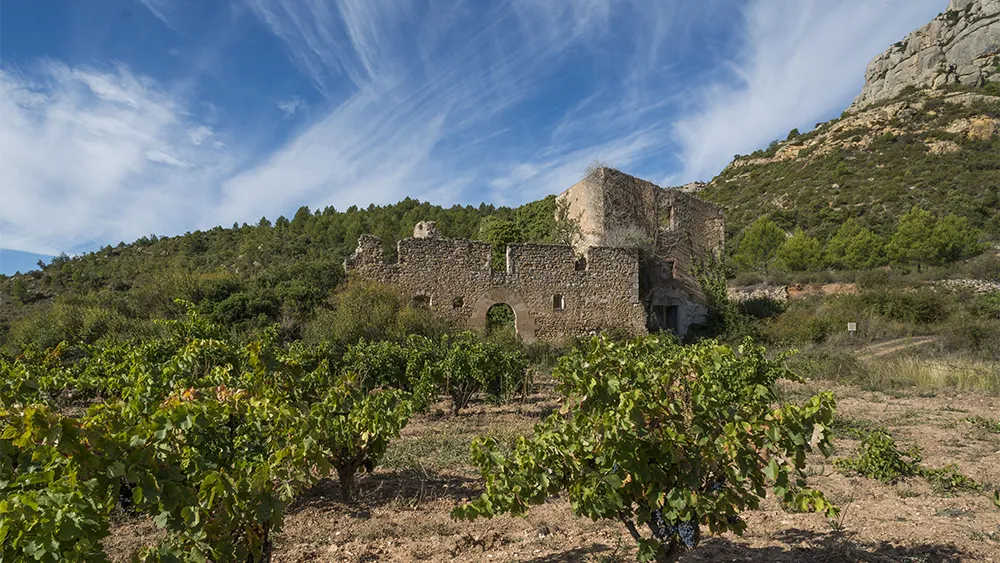
SCALA DEI, PRIORAT, SPAIN
While the sensation of minerality can be less obvious in red wines, Spanish Garnacha and Sicilian Nerello Mascalese are two grapes that often exhibit it, thanks to both the locales from which they hail as well as the often-judicious use of oak. The slopes of eastern Sicily’s Mount Etna are covered with volcanic soils composed of pumice, black ash and basalt. Priorat, a region close to Barcelona in northeast Spain, is blessed with black quartz, slate and mica soils called llicorella. Here you will find vineyards covered with small fragments of black and grey striated rock sitting atop blue and red soils embedded with the same.
Ricard Rofes, winemaker at Scala Dei in Priorat, refers to its Mas Deu vineyard as one of the winery’s “jewels.” The origin of Scala Dei Tribut and Masdeu, it sits 800 meters (2,625 feet) above sea level. Rofes told Robb Report, “In this elevated area the clay and limestone soils are ideal for growing Grenache, giving the wine that touch of acidity and freshness that makes it unique. The red-clay soils and the altitude of the vineyards located in the lap of the Sierra de Montsant give it freshness and the llicorella soils impart a genuine imprint. Our wine is the pure expression of the fruit and the terroir with a distinct personality.”
You may also like.
Best fo Europe: Six Senses, Switzerland
Mend in the mountains at Crans-Montana.
Wellness pioneer Six Senses made a name for itself with tranquil, mostly tropical destinations. Now, its first alpine hotel recreates that signature mix of sustainable luxury and innovative spa therapeutics in a world-class ski setting.
The ski-in, ski-out location above the gondola of one of Switzerland’s largest winter sports resorts allows guests to schuss from the top of the Plaine Morte glacier to the hotel’s piste-side lounge, where they can swap ski gear for slippers, then head straight to the spa’s bio-hack recovery area to recharge with compression boots, binaural beats and an herb-spiked mocktail. In summer, the region is a golf and hiking hub.
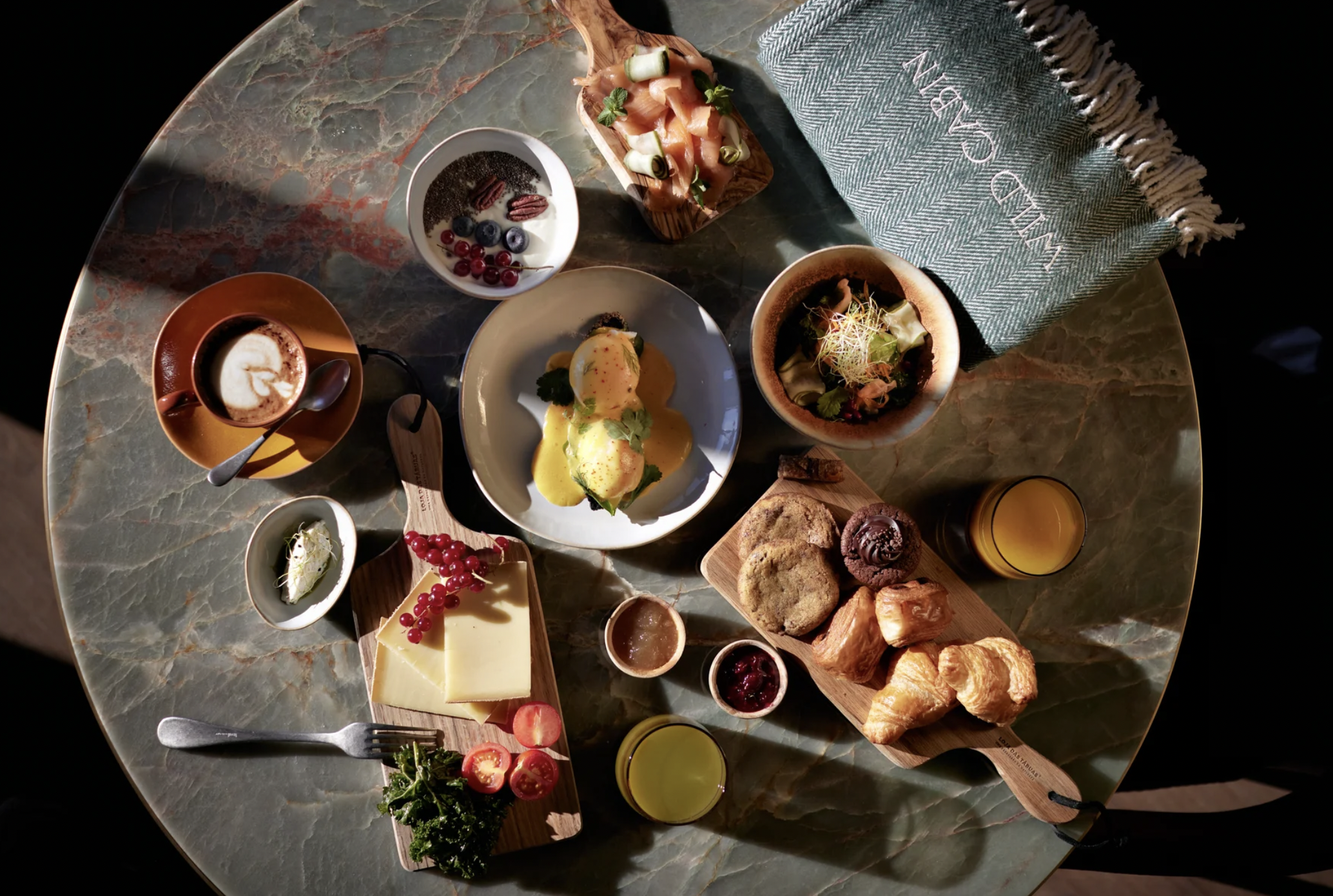
The vibe offers a contemporary take on chalet style. The 78 rooms and suites are decorated in local larch and oak, and all have terraces or balconies with alpine views over the likes of the Matterhorn and Mont Blanc. With four different saunas, a sensory flotation pod, two pools
and a whimsical relaxation area complete with 15,000 hanging “icicles” and views of a birch forest, the spa at Six Senses Crans-Montana makes après ski an afterthought.
You can even sidestep the cheese-heavy cuisine of this region in favour of hot pots and sushi at the property’s Japanese restaurant, Byakko. Doubles from around $1,205; Sixsenses.com
You may also like.
Watch of the Week: TAG Heuer Formula 1 | Kith
The legendary sports watch returns, but with an unexpected twist.
Over the last few years, watch pundits have predicted the return of the eccentric TAG Heuer Formula 1, in some shape or form. It was all but confirmed when TAG Heuer’s heritage director, Nicholas Biebuyck, teased a slew of vintage models on his Instagram account in the aftermath of last year’s Watches & Wonders 2023 in Geneva. And when speaking with Frédéric Arnault at last year’s trade fair, the former CEO asked me directly if the brand were to relaunch its legacy Formula 1 collection, loved by collectors globally, how should they go about it?
My answer to the baited entreaty definitely didn’t mention a collaboration with Ronnie Fieg of Kith, one of the world’s biggest streetwear fashion labels. Still, here we are: the TAG Heuer Formula 1 is officially back and as colourful as ever.
As the watch industry enters its hype era—in recent years, we’ve seen MoonSwatches, Scuba Fifty Fathoms, and John Mayer G-Shocks—the new Formula 1 x Kith collaboration might be the coolest yet.

Here’s the lowdown: overnight, TAG Heuer, together with Kith, took to socials to unveil a special, limited-edition collection of Formula 1 timepieces, inspired by the original collection from the 1980s. There are 10 new watches, all limited, with some designed on a stainless steel bracelet and some on an upgraded rubber strap; both options nod to the originals.
Seven are exclusive to Kith and its global stores (New York, Los Angeles, Miami, Hawaii, Tokyo, Toronto, and Paris, to be specific), and are made in an abundance of colours. Two are exclusive to TAG Heuer; and one is “shared” between TAG Heuer and Kith—this is a highlight of the collection, in our opinion. A faithful play on the original composite quartz watch from 1986, this model, limited to just 1,350 pieces globally, features the classic black bezel with red accents, a stainless steel bracelet, and that creamy eggshell dial, in all of its vintage-inspired glory. There’s no doubt that this particular model will present as pure nostalgia for those old enough to remember when the original TAG Heuer Formula 1 made its debut.

Of course, throughout the collection, Fieg’s design cues are punctuated: the “TAG” is replaced with “Kith,” forming a contentious new brand name for this specific release, as well as Kith’s slogan, “Just Us.”
Collectors and purists alike will appreciate the dedication to the original Formula 1 collection: features like the 35mm Arnite cases—sourced from the original 80s-era supplier—the form hour hand, a triangle with a dot inside at 12 o’clock, indices that alternate every quarter between shields and dots, and a contrasting minuterie, are all welcomed design specs that make this collaboration so great.
Every TAG Heuer Formula 1 | Kith timepiece will be presented in an eye-catching box that complements the fun and colour theme of Formula 1 but drives home the premium status of this collaboration. On that note, at $2,200 a piece, this isn’t exactly an approachable quartz watch but reflects the exclusive nature of Fieg’s Kith brand and the pieces he designs (largely limited-edition).

So, what do we think? It’s important not to understate the significance of the arrival of the TAG Heuer Formula 1 in 1986, in what would prove integral in setting up the brand for success throughout the 90’s—it was the very first watch collection to have “TAG Heuer” branding, after all—but also in helping to establish a new generation of watch consumer. Like Fieg, many millennial enthusiasts will recall their sentimental ties with the Formula 1, often their first timepiece in their horological journey.
This is as faithful of a reissue as we’ll get from TAG Heuer right now, and budding watch fans should be pleased with the result. To TAG Heuer’s credit, a great deal of research has gone into perfecting and replicating this iconic collection’s proportions, materials, and aesthetic for the modern-day consumer. Sure, it would have been nice to see a full lume dial, a distinguishing feature on some of the original pieces—why this wasn’t done is lost on me—and perhaps a more approachable price point, but there’s no doubt these will become an instant hit in the days to come.
—
The TAG Heuer Formula 1 | Kith collection will be available on Friday, May 3rd, exclusively in-store at select TAG Heuer and Kith locations in Miami, and available starting Monday, May 6th, at select TAG Heuer boutiques, all Kith shops, and online at Kith.com. To see the full collection, visit tagheuer.com
You may also like.
Best of Europe: Grand Hotel Des Étrangers
Fall for a Baroque beauty in Syracuse, Italy.
Sicily has seen a White Lotus–fuelled surge in bookings for this summer—a pop-culture fillip to fill up its grandes dames hotels. Skip the gawping crowds at the headline-grabbers, though, and opt instead for an insider-ish alternative: the Grand Hotel des Étrangers, which reopened last summer after a gut renovation.
It sits on the seafront on the tiny island of Ortigia in Syracuse, all cobbled streets and grand buildings, like a Baroque time capsule on Sicily’s southeastern coast.
Survey the entire streetscape here from the all-day rooftop bar-restaurant, Clou, where the fusion menu is a shorthand of Sicily’s pan-Mediterranean history; try the spaghetti with bottarga and wild fennel or the sea bass crusted in anchovies. Idle on the terrace alfresco with a snifter of avola, the rum made nearby.
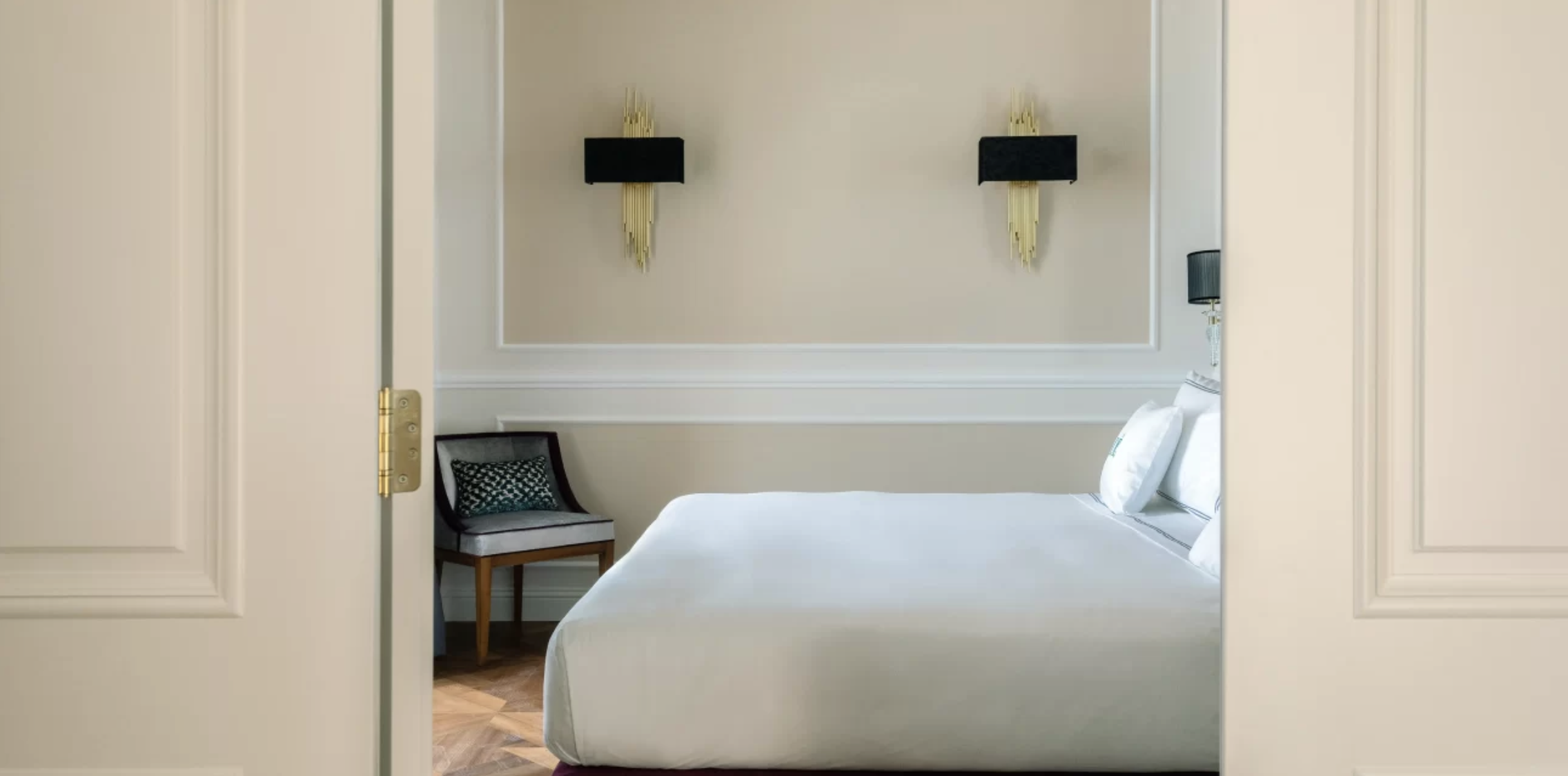
As for the rooms, they’ve been renovated with Art Deco–inflected interiors—think plenty of parquet and marble—but the main asset is their aspect: the best of them have private balconies and a palm tree-fringed view out over the Ionian Sea. Doubles from around $665; desetranger.com
You may also like.
8 Fascinating Facts You Didn’t Know About Aston Martin
The British sports car company is most famous as the vehicle of choice for James Bond, but Aston Martin has an interesting history beyond 007.
Aston Martin will forever be associated with James Bond, ever since everyone’s favourite spy took delivery of his signature silver DB5 in the 1964 film Goldfinger. But there’s a lot more to the history of this famed British sports car brand beyond its association with the fictional British Secret Service agent.
Let’s dive into the long and colourful history of Aston Martin.







